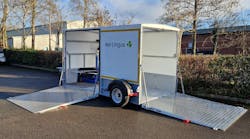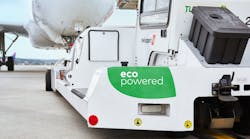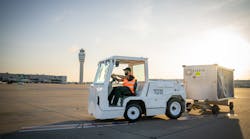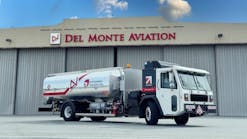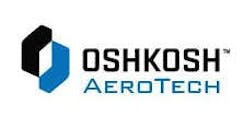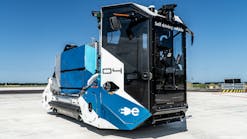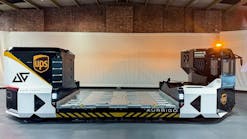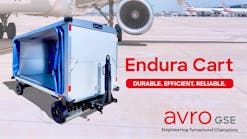Across the industry, ground support equipment (GSE) manufacturers are striving to meet customer demands for more electric equipment. The following are just a few examples of how equipment is helping ground handlers, airlines and airports meet sustainability goals and adopt equipment powered by alternative energy.
TLD to Phase Out Mechanical Drivelines by 2024
Officials at TLD identified three main challenges currently facing the ground support industry – the need for sustainability; growing and developing the skills and competencies of the workforce with new technologies; and a constant cost challenge in a competitive world.
To simultaneously address these challenges, TLD is introducing its Alternative Power Source solution to customers and announcing its objective to stop mechanical drivelines by the end of 2024.
According to Valentin Schmitt, CEO of TLD Group, the major hurdle on electrification today, which is shared by the company’s entire customer base, is the gap with infrastructure. This includes the position of and type of chargers, as well as the number of chargers or charging slots
“The differentiation of our Alternative Power Source strategy is to propose our customers standardize around electric GSE, but with various types of power sources – batteries, hybrid systems with on-board generators, hydrogen fuel cells, or on-board chargers compatible with 400 Hz,” Schmitt says, adding with different, interchangeable building blocks individual customers can define the electric GSE that will fit with current infrastructure and continue to evolve as the infrastructure grows.
Moving forward, Schmitt says all mobile GSE from TLD will come with a “future ready” electric driveline. The Alternative Power Sources of these drivelines include fully electric options with TLD’s iBS lithium-ion batteries; hybrid versions with its iHS or ipHS hybrid packs; and hydrogen.
“This is a major push towards sustainable aviation, with a set of technical solutions allowing to decouple the electrification of the GSE, expected by all players, from the infrastructure, which might take longer to adapt and will propose different alternatives depending on the regions,” Schmitt says.
By decoupling the electrification of the GSE from the infrastructure, TLD officials say ground handlers can embark on sustainability goals immediately and use the natural renewal of a fleet to grow the electrification ratio.
This will allow customers to avoid facing a “CapEx wall” in 5 or 10 years with a large part of the fleet to be renewed in a short period, Schmitt says.
“The standardization of the solution around a few components that will be available for all GSE – TLD and non-TLD, by the way – will simplify the maintenance training and improve the adaptation of the teams’ skills to those evolving technologies,” he says.
A key challenge for TLD was developing a one-size-fits-all solution, with a battery or hybrid pack being common for almost all GSE.
“This is not only bringing simpler maintenance, a lower inventory for parts, or simpler training. It is allowing (customers) to swap those systems from one application to another, aging the batteries over several lives in those different applications. This will drive the TCO even lower,” Schmitt says.
Electric and hybrid solutions are now available on more product lines and should be available on almost everything by the end of 2022, according to Schmitt.
“We believe that every customer today has, at a different level, a sustainability agenda. And for those who don’t, I am sure they are actively working on it to avoid losing ground against the competition,” he says. “There is a lot to learn, but this is also lowering the cost base and creating competitiveness for the future.”
Aviogei Introduces Hydrogen Hybrid Powertrain
At the GSE Expo Europe, Aviogei presented a small-scale prototype of a hydrogen hybrid powertrain developed for ground support equipment.
The hydrogen powertrain, which will be installed on a vehicle for passengers with reduced mobility (PRM) is being carried out in collaboration with the Industrial Electronics Laboratory of the Electrical and Information Engineering Department at the University of Cassino and Southern Latium.
“Hydrogen will play a key role in the transition to renewable energy sources,” says Andrea Cesarini, CEO at Aviogei Airport Equipment. “It is the best choice for at-scale decarbonization, as it is an inexhaustible source that can be produced from many sources and has a high-energy power – about 2.5 times more than methane. Aviogei has contact in progress with Italian airports that have ongoing hydrogen projects.”
Along with the University of Cassino, Aviogei began a project for hydrogen propulsion equipment in 2013. But at that time, it was too early for the technology to be accepted at airports, Cesarini explains.
“Now the landscape has totally changed and airports are already organizing an appropriate infrastructure for the accumulation of hydrogen cells,” he says, noting some Italian airports have launched green hydrogen storage and distribution initiatives.
As a member of H2IT, Aviogei is focused on the development of hydrogen powered solutions. H2IT is the Italian Hydrogen and Fuel Cells association, which brings enterprises, research centers, universities, technology clusters and local entities together to work in the hydrogen sector in Italy.
“H2IT aims at stimulating the creation of the infrastructure for the use of hydrogen, ensuring a leadership role for Italy in the international market. We have also partners for the fuel cells and we are collaborating with lab research,” he says.
Still in the development phase, Aviogei’s first goal has been to achieve the feasibility and performance of a hybrid propulsion system powered by hydrogen and lithium polymer batteries. From there, Cesarini says the goal is to expand offerings and further support customers’ decarbonization efforts.
“The project will have an important impact on the decarbonization of the airport industry, contributing to the achievement of the objectives of the airports committed to the net zero targets,” he adds. “In particular, the European aviation industry is strongly committed to reaching net zero CO2 emissions and contribute to the goals set in the European Green Deal and the Paris Agreement.”
While this initial hydrogen project has been applied to a PRM vehicle, Cesarini says the company intends to extend the use of the technology to all of its GSE production.
“We have detected interest in this new technology and in our programs,” he concludes.
JBT Expands Beyond eGSE
Having supplied its JetAire PCAir and Jetpower 400 Hz products for several years, officials at JBT AeroTech note the company’s commitment to saving fuel and reducing aviation’s carbon footprint.
More recently, points out Gary Walter, vice president – global sales and customer care at JBT AeroTech, JBT has introduced a series of electric pushback tractors, mobile stairs, cargo transporters and 15k to 30k cargo loaders in addition to environmentally focused defense products.
JBT is continuing to broaden its green focus beyond its family of eGSE with its AmpTek, iOPS and JetDock solutions.
JBT aims to reduce the challenges and costs associated with ramp electrification through its AmpTek solution.
“For example, charging stations can be too far from work zones, electrical grids may need upgrading, and laying power lines and civil works can prove disruptive. All these realities are expensive and time-consuming and act as impediments to going green,” Walter says.
AmpTek gets power to battery chargers in a unique way that avoids or reduces infrastructure costs and minimizes GSE transit times to remote charging locations.
“AmpTek intelligently uses excess power available at the boarding bridge gate and distributes that surplus power to the battery chargers. Battery chargers can be located at the gate close to the work, grid upgrades are avoided, there is almost no construction work involved and the AmpTek devices intelligently monitors battery status and health,” Walter says.
JBT officials have also sought a solution for getting the most out of current GSE fleets while using a minimum of fuel. Walter says the iOPS Fleet Management telematics system can make a difference.
“With iOPS you can manage your fleet in real time on your mobile or desk-mounted devices,” he says, noting tracking engine idle time, for example, can save money and fuel by eliminating wasted hours of engine run time.
iOPS users can reduce GSE travel time and related wear and tear by monitoring fleet traffic patterns and establishing efficient fleet use plans. Unexpected maintenance and downtime can be avoided with notifications for pending preventive maintenance (PM) needs and status updates. What’s more, aircraft auxiliary power unit (APU) burn time can be reduced.
“Our customers are aggressively monitoring their gate processes for hooking up their PCAir and ground power devices so that APUs can be shut off,” Walter says.
“These are a few samples of what iOPS Fleet Management telematics can do for managers,” he adds. “The savings can be tremendous and the benefit to the environment incalculable.”
JetDock is designed to provide environmental benefits through faster turnaround times by assisting operators of cargo loaders, boarding bridges and more to dock quickly and safely with parked aircraft.
“With JetDock both aircraft damage and turn times are reduced. The lidar, sensors, and sophisticated adaptive software get your GSE to the aircraft door in record time so passengers and cargo move on and off the plane as expeditiously as possible,” Walter says. “This translates to a reduction in wasted fuel for your GSE and for the aircraft APU.”
According to Walter, JBT’s new eGSE has been well received by airline and cargo customers. He says the company is continuing to invest in developing new battery powered GSE while expanding research and development efforts to other, non-traditional projects that have an immediate and positive impacts on the environment.
“With AmpTek, iOPS and JetDock we augment and hasten aviation’s efforts to walk the green path and reduce our industry’s carbon footprint,” he says.
Waev’s Modular Approach to eGSE
Waev Inc. has recently introduced lithium-powered tow tractors that meet payload requirements of all-day duty cycles to assist airports in meeting demands to cut carbon emissions. The company’s Li-Ion Tiger and Bigfoot lines do not produce emissions, require minimal maintenance and utilize common parts to ease the transition to a lithium-ion fleet.
“And the infrastructure requirements can scale with the fleet, as required, starting with as little as dedicated 110v-240v single phase outlets up to 480v fast charging options,” says Gerry Hoadley, director of ground support equipment at Waev. “This makes the transition much easier and allows it to be done in phases.”
The Li-ion Tiger is a conventional baggage/cargo tractor has a towing capacity of up to 60,000 pounds and can be equipped with a 36kWh or 48kWh power module. The tractors can be charged using Waev’s standard on-board 6.6kW charger or it can be equipped for 480v fast charging. For smaller operations that require less capacity, the Bigfoot XL burden carrier can tow 10,000 lbs and can be equipped with an array of battery options.
“We use only LiFePO4 cells in our lithium power modules which is known to be one of the most stable chemistries in the battery industry,” Hoadley says. “At the end of the serviceable life of our power modules, the cells can be utilized for energy storage in things such as power walls and off-grid power sources.”
Most serviceable components used in the Tiger tractors are based on industry standards, so service parts from existing fleets can often be used. The modular chassis eases the maintenance transition too. The chassis can accommodate battery packs or internal combustion engines (ICE). Then if a customer wants to convert a diesel-powered tractor to battery power, the chassis easily allows it.
“We’re developing the repower packages now to provide customers with everything needed to upgrade legacy ICE powered tractor fleets,” Hoadley says.
What’s more, the Li-Ion Tiger’s anti-rollover system automatically slows to a safe speed when a driver enters a turn too aggressively, mitigating the chances of a roll-over.
According to Hoadley, customer feedback about the new tractors have been positive and more airlines and ground handlers are turning to lithium-ion battery technology. He suggests that anyone interested in using Li-ion-powered equipment do their homework and better understand how their fleet can utilize the technology.
“We need to do a better job of informing fleet managers about all considerations of electrification,” Hoadley says. “Yes, you will you have to train and remind operators to plug in the tractors, but you can opportunity charge – or top-off – without causing damage to the battery, something non-Lithium batteries struggle with.
“You can charge on a dedicated, single-phase outlet (110v to 240v), but you can charge quicker with infrastructure upgrades like 480v fast smart chargers,” he adds.
ITW Pilots Mark II at JFK
When ITW GSE conducted a 120-day pilot at John F. Kennedy International Airport's Terminal 4 (JFKIAT) for its battery-driven electric ground power units (eGPUs), it allowed international carriers like Singapore Airlines and Emirates to use ITW’s Mark II 180 kVA unit.
Since then, officials at ITW GSE say the eGPU has gained wider adoption across America, including at San Francisco International Airport (SFO) where United Airlines is using the unit to power a Boeing 777-200.
As the largest terminal at JFK Airport was undergoing expansion, JFKIAT wanted to promote a sustainable environment which included the reduction of greenhouse gas emissions. By incorporating zero-emission ground support equipment, airport officials could achieve their goal and have an alternative to diesel powered GPUs thus reducing the use of fossil fuels and CO2 emissions.
“We are helping airports obtain their airport carbon accreditation, which is the only institutionally endorsed, carbon management certification standard for airports,” says Alberto Rocha, sales director, Americas, at ITW GSE. “All these efforts are paving the way for airports in north America to manage and reduce their carbon emissions.”
According to ITW GSE officials, the 180 kVA unit reduces CO2 and NOx; requires almost no maintenance; reduces noise pollution to improve the working environment; is not dependent on fossil fuel; and provide flexibility as it can easily be used indoors in hangars or maintenance facilities as well as outdoors wherever it is needed.
While ITW GSE’s 28 VDC and 90 kVA units helped pave the way for the introduction of the Mark II 180 kVA unit, challenges still existed around acceptance and the cultural change of using an eGPU that does not need fuel. But ITW officials say they worked with customers to inform industry members and train them about the technology.
“The unknown can be scary, and people tend to let others take the leap first because it is safer. Therefore, it is part of our job as innovators to educate and prove those fears to be untrue. This is what we did with the eGPU,” Rocha says.
Infrastructure was also a barrier for adoption as many airports do not have enough charging points for eGSE. However, in last year or two positive change has begun to happen, and airports are installing more chargers for ground support equipment, according to ITW GSE officials.
With a complete family of battery-driven eGPUs, the product line covers all aircraft needs. However, officials at ITW GSE say they will continue to supply the aviation industry with clean, reliable and cost efficient GSE systems.
Kalmar Builds on eGSE Reputation
As the GSE industry increasingly adopts electric-powered equipment, Kalmar Motor is relying on its 14 years of experience producing electric conventional and towbarless tractors.
In 2008, facing global economic downturn, Kalmar owner and managing director Magnus Johansson faced three options. The first was to scale down the company to meet the sales and production requirements. The second was to maintain its current workforce and hope the downturn wouldn’t last. Option three was to invest in the future with development and production of full electric powered tractors.
Johansson opted to move forward with the electrification of the Kalmar Motor product range.
“The goals for producing full electric power tractors with Lithium-ion batteries was to create tractors with the same operational capability of the diesel version but with a fraction of the operating costs and most importantly, reduce CO2 emissions,” says Sean Bryan, technical sales manager at Kalmar Motor. “Following the investment of company resources Kalmar Motor's first full electric powered tractor, the TBL50EL was delivered to SAS airlines in 2009.”
According to Kalmar officials, SAS reduced its operational and maintenance costs after deploying the TBL50EL. More product development was completed as SAS used the tractors at Kastrup Airport (CPH) in Copehagen. Now, 60-70 percent of Kalmar’s production is electric powered tractors operating in Sweden, Denmark, Norway, Finland, Germany, Portugal, France, UAE, India, China, Japan, Hong Kong, New Zealand, USA and Japan.
While electric pushbacks and tow tractors offer reduced emissions and lower operating and maintenance costs, charging infrastructure has been a question facing the industry.
“Generally the challenge for ground handlers is that the infrastructure for charging power is controlled by the airport authorities and even though they encourage ground handlers to use electric equipment on the airport, they are not so fast to react to requirements,” Bryan says. “This is something that we are sure will change over time and we do acknowledge that adapting the airport for a complete change would be very difficult. However, a staged transition of equipment type is much simpler for all involved.”
Since the first TBL50EL was delivered in 2009, Kalmar Motor introduced the TBL190EL and TBL800EL in 2015, followed by the TBL180EL and the TBL100E. Kalmar’s conventional range of tractors includes the FB150E, which was first delivered in 2010, followed by the FB250EL and then the FB600EL.
Today all of the company’s aircraft towing tractors are available in full-electric drive with many models now exclusively available as electric units.
“We have also developed our systems and created a multitude of charging options, including regenerative charging, AC charging, DC charging, 400Hz charging, range extender charging and GPU/range extender charging to cater for all customer operational demands,” Bryan says. “The next step is quite possibly the introduction of hydrogen fuel cell recharging of the tractor batteries to give even cleaner and more efficient charging options.”
Textron's Collaboration with PCS and GM
Since 2013, Textron GSE has worked with Powertrain Control Solutions (PCS) and General Motors (GM) to integrate GM technologies into products that meet the unique and rigorous requirements of the GSE industry.
That relationship has continued and ultimately resulted in the newly released TUG Endurance Baggage Tractor.
“Textron GSE is committed to sustainability and being a catalyst for its customers and the industry to achieve their sustainability initiatives. The TUG Endurance baggage tractor is the perfect example of designing a product that considers customer requirements for performance, productivity and safety on a global scale,” says Matt Chaffin, vice president and general manager at Textron GSE. “Emphasis was placed on building a product with technology specifically for ground support applications that could evolve as electrification becomes paramount in the future.”
According to Chaffin, the TUG Endurance was developed based on direct feedback from customers.
“Textron GSE explored various technologies and identified an opportunity to collaborate with two industry-leading companies: General Motors and PCS,” Chaffin says. “Together, GM and PCS have developed an integrated driveline, specifically designed for Textron GSE products that utilizes GM’s lithium-ion battery systems.
“The driveline will allow Textron GSE to leverage GM’s experience in electric propulsion solutions, honed over more than 25 years of developing a variety of electric vehicle systems and other zero-emissions innovations.”
Among its features, the TUG Endurance leverages high-capacity GM and PCS lithium technology, utilizing the J1772 connector for level 2 AC charging, as well as DC fast charging. The systems constantly monitors for ground faults, disconnected connectors or other potential hazards, and includes a manual safety disconnect for lock-out/tag-out procedures. In addition, the systems will incorporate innovative safety features introduced by PCS into the GSE industry, such as electronic transmission controls, and an electric parking brake, both of which communicates with the vehicle’s electric drivetrain and other onboard systems to enhance safety.
Additional features include a single chassis with the choice of a cab forward or cab aft driving position; an electronic parking brake that automatically engages if someone leaves the seat, or the tractor shifts into neutral; an electronic shifter and throttle to deliver ease of use with an automotive experience and enhanced safety; an automatic park brake application and release, which is programmed into the operation logic reducing operator error; and brake i-booster – an electric assist on brake activation to reduce the effort required, but in the event of a fault, the driver still has mechanical braking.
What’s more, the tractor offers the ability to integrate vehicle telematics for benefits such as swipe access, collision monitoring, fault monitoring, geofencing, etc. The TUG Endurance features autonomous ready control systems; a modular design; Bluetooth remote diagnostics; a multi-function display to communicate hours, fuel level or state of charge; a standard e-hitch; and standard LED headlights, stop/taillights, side repeaters and back up light. The vehicle is designed with drive by wire for increased operator comfort ; and it offers an interchangeable drivetrain that enables globally compliant gas and diesel models to be upgraded to lithium as infrastructures evolve.
One of the biggest challenges was designing a single product that met a wide variety of customer needs, according to Chaffin.
“The primary focus of our efforts on the TUG Endurance was around capturing high take-rate options and incorporating them into the standard design either as standard features or as plug-and-play add-ons,” he says. “This helps increase throughput in our factory and increases overall product quality and reliability.”
The TUG Endurance baggage is available in a lithium powertrain, which Chaffin says assists both customers and the industry in achieving sustainability objectives as they require no maintenance and offer zero tail pipe emissions.
The lithium TUG Endurance uses a J1772 connector for level 2 AC charging, and DC fast charging.
“This type of charging is prevalent in the automotive industry and can be found in ground support equipment such as buses, catering trucks and high lifts. Utilizing these charging platforms can help alleviate infrastructure constraints,” Chaffin says.
“Most customers are aware of the shift to high voltage systems and many of them are already pursuing that technology on their own,” he continues. “Customer feedback was supportive of the direction we chose for the TUG Endurance EV drivetrain and were complementary of the automotive level of safety and quality integration.”
According to Chaffin, Textron GSE is always looking for ways to enhance its product solutions.
“Collaborating with GM and PCS will enable us to explore additional opportunities to synergize and electrify products across our brands,” he concludes.


